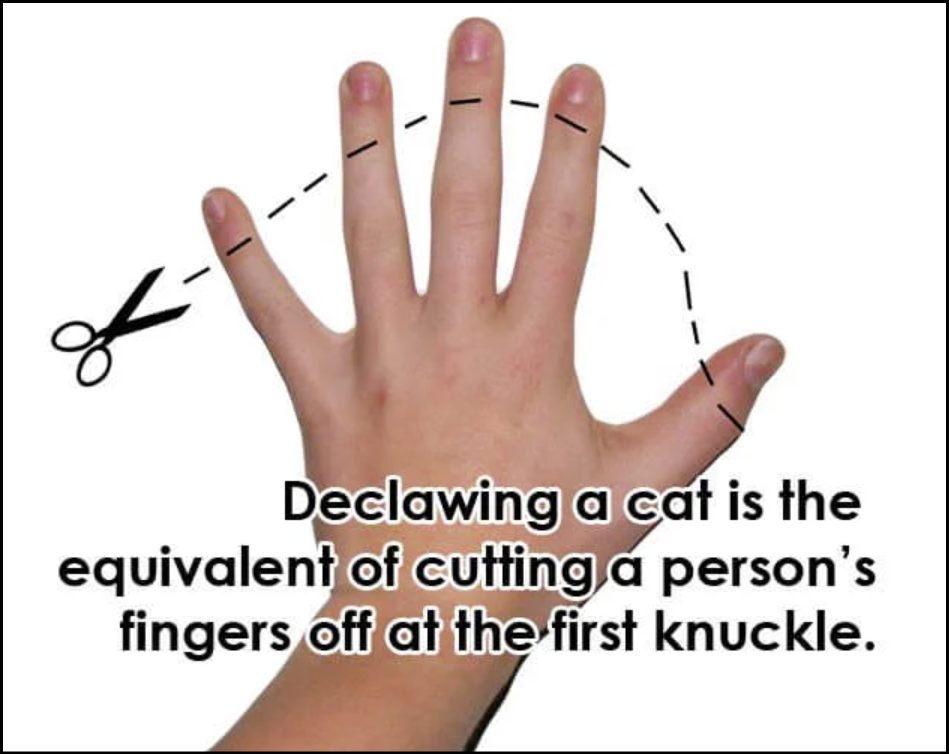Today, let’s let’s look into a hot-button topic that has stirred debates within the feline-loving community: declawing cats. This controversial practice has been a subject of concern, prompting discussions about its ethical implications and potential impact on our furry friends’ well-being.
What Is Cat Declawing

Declawing, or onychectomy, is a surgical procedure that involves the removal of the last bone of each of the cat’s toes where the claw grows from. While some may consider it a solution to prevent scratching-related issues, it has the potential to create serious health consequences and can have a negative impact on the emotional well-being of your cat.
The Physical Health Considerations
Declawing can cause paw pain, back pain, infection, tissue necrosis (tissue death) and lameness. Removing claws changes the way a cat’s feet meet the ground and can cause pain like wearing an uncomfortable pair of shoes. Improperly removed claws can regrow, causing nerve damage and bone spurs.
For several days after surgery, shredded newspaper is typically used in the litter box to prevent litter from irritating declawed feet. This unfamiliar litter substitute, accompanied by pain when scratching in the box, may lead cats to permanently avoid using the litter box. Some cats may become biters because they are in pain and no longer have their claws for defense.
Why you shouldn’t declaw a cat | The Humane Society of the United States
You can download their excellent declawing fact sheet here.
The Emotional Toll
Many studies suggest that declawing can have emotional repercussions for your cats. Felines rely on their claws for various activities, such as stretching, marking territory, and defending themselves. Depriving them of this natural behavior may lead to stress and anxiety, affecting their overall emotional well-being.
Legislation and Bans
On Thursday, January 18, 2024, the Massachusetts state senate unanimously passed bill S 2552 to outlaw declawing surgery on cats. If passed into law, Massachusetts would become the third state in the union to ban this practice.
“Declawing is an abhorrent practice that most veterinarians view as inhumane,” Sen. Mark Montigny, the lead sponsor of the bill, said. “But it is also a procedure that is widely misunderstood and requested by owners. By passing this legislation, veterinarians will no longer have to weigh the choice, knowing that if they don’t provide the procedure an owner is likely to just look for someone who will.”
A legal patchwork
In the United States, only New York (2019) and Maryland (2022) have passed statewide declawing bans.
Some local grassroot organizations have managed to get declawing bans enacted in the following cities:
- Allentown, Pennsylvania
- Austin, Texas
- Berkeley, California
- Beverly Hills, California
- Burbank, California
- Culver City, California
- Denver, Colorado
- Los Angeles, California
- Madison, Wisconsin
- Pittsburgh, Pennsylvania
- St. Louis County, Missouri
- St. Louis, Missouri
- San Francisco, California
- Santa Monica, California
- Tacoma, Washington
- West Hollywood, California
While else where in the world, there are a few countries where the practice of declawing has been banned nationwide:
Australia
Austria
Belgium
Bosnia and Herzegovina
Brazil
Bulgaria
Cyprus
The Czech Republic
Denmark
England
Finland
France
Germany
Greece
Ireland
Israel
Italy
Latvia
Lithuania
Luxembourg
Macedonia
Malta
Montenegro
The Netherlands
New Zealand
Northern Ireland
Norway
Portugal
Romania
Scotland
Serbia
Slovenia
Spain
Sweden
Switzerland
Turkey
Ukraine
Wales
In Canada, it is up to the veterinary regulators in each province to ban the practice. As of this writing, declawing has been banned by the Veterinary Associations of all provinces except for Ontario.
Alternatives to Declawing
It’s essential to consider alternative solutions for a scratching problem. Simply providing acceptable scratching surfaces like scratching posts and scratch pads can go a long way to resolving the issue. You can sprinkle these appropriate surfaces with catnip or silver vine to make them more attractive. You can discourage your cat from scratching inappropriate items like a chair or sofa with aluminum foil or double-sided sticky tape. Not only that, but you can also spritz them with a fabric safe citrus scent or a “feel safe” cat pheromone like Feliway. Keeping your cat’s nails well trimmed will also help. Alternatively, you can put soft nail caps over your cat’s claws. Common brands are Soft Claws, Purrdy Paws and Kitty Caps. And finally, you can consult an animal behaviorist.
The Role of Veterinarians
Understanding the role of veterinarians in the declawing debate is crucial. Responsible veterinarians prioritize the well-being of their feline patients, offering guidance on alternative solutions and educating cat owners about the potential risks associated with declawing.
Conclusion:
In conclusion, the controversy over cat declawing reflects the ongoing dialogue within the cat-loving community. As responsible cat owners, it’s our duty to explore alternatives, prioritize our feline friends’ well-being, and advocate for ethical treatment. By staying informed and making informed decisions, we can contribute to creating a happier and healthier environment for our beloved cats.






